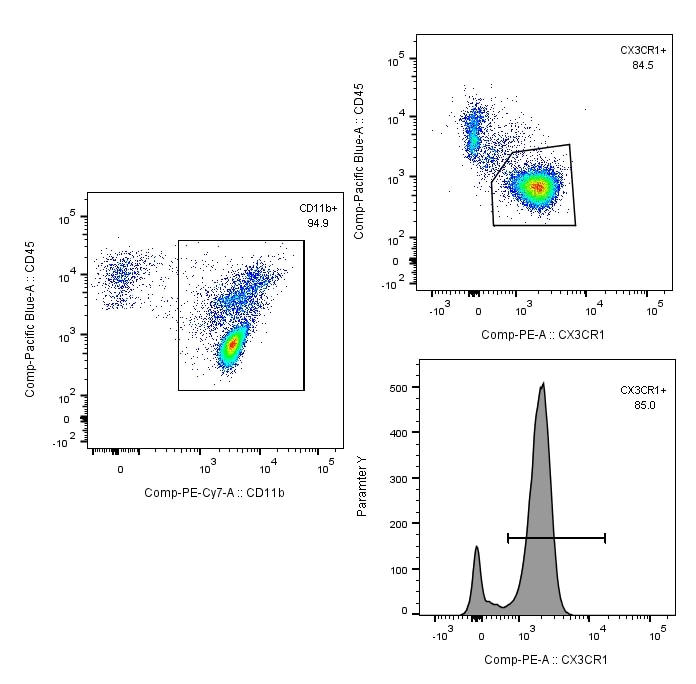Mouse CX3CR1 PE-conjugated Antibody Summary
Met1-Thr32, Leu92-Lys104, Thr169-Val196, Lys258-Leu274
Accession # Q9Z0D9
Applications
Please Note: Optimal dilutions should be determined by each laboratory for each application. General Protocols are available in the Technical Information section on our website.
Scientific Data
 View Larger
View Larger
Detection of CX3CR1 in Mouse Splenocytes by Flow Cytometry. Mouse splenocytes were stained with Goat Anti-Mouse CX3CR1 PE-conjugated Antigen Affinity-purified Polyclonal Antibody (Catalog # FAB5825P) and Anti-Mouse Integrin aX/CD11c FITC-conjugated Mono-clonal Antibody. Quadrant markers were set based on control antibody staining (Catalog # IC108P). View our protocol for Staining Membrane-associated Proteins.
 View Larger
View Larger
Detection of CX3CR1 in CHO Chinese Hamster Cell Line Transfected with Mouse CX3CR1 and eGFP by Flow Cytometry. CHO Chinese hamster ovary cell line transfected with either (A) mouse CX3CR1 or (B) irrelevant transfectants and eGFP was stained with Goat Anti-Mouse CX3CR1 PE-conjugated Antigen Affinity-purified Polyclonal Antibody (Catalog # FAB5825P). Quadrant markers were set based on control antibody staining (Catalog # IC108P). View our protocol for Staining Membrane-associated Proteins.
Reconstitution Calculator
Preparation and Storage
- 12 months from date of receipt, 2 to 8 °C as supplied.
Background: CX3CR1
CX3CR1 (CX3C chemokine receptor 1; also known as fractalkine receptor, GPCR13 and V28) is a 40 kDa member of the δ-group of rhodopsin GPCRs. It is expressed on astrocytes, microglia, macrophages, Th1 and Tc1 T cells, NK cells, mouse Gr1lo monocytes plus smooth muscle and mast cells. CX3CR1 mediates adhesion to fractalkine, promotes avid binding of integrins to their ligands, and extends the life of monocytes. Mouse CX3CR1 is a 7-transmembrane protein that is 354 amino acids (aa) in length. It contains a 32 aa N-terminal extracellular region that shows no glycosylation, and a 56 aa C-terminal cytoplasmic domain. Over aa 1‑32, 91‑104, 169‑196 and 258‑274 collectively, mouse CX3CR1 shares 96% and 77% aa identity with rat and human CX3CR1, respectively.
Product Datasheets
Citations for Mouse CX3CR1 PE-conjugated Antibody
R&D Systems personnel manually curate a database that contains references using R&D Systems products. The data collected includes not only links to publications in PubMed, but also provides information about sample types, species, and experimental conditions.
9
Citations: Showing 1 - 9
Filter your results:
Filter by:
-
The immune response after noise damage in the cochlea is characterized by a heterogeneous mix of adaptive and innate immune cells
Authors: V Rai, MB Wood, H Feng, NM Schabla, S Tu, J Zuo
Scientific Reports, 2020-09-16;10(1):15167.
Species: Mouse
Sample Types: Whole Cells
Applications: Flow Cytometry -
Radiation Triggers a Dynamic Sequence of Transient Microglial Alterations in Juvenile Brain
Authors: AM Osman, Y Sun, TC Burns, L He, N Kee, N Oliva-Vila, A Alevyzaki, K Zhou, L Louhivuori, P Uhlén, E Hedlund, C Betsholtz, VM Lauschke, J Kele, K Blomgren
Cell Rep, 2020-06-02;31(9):107699.
Species: Mouse
Sample Types:
Applications: IHC -
Unique molecular signature in mucolipidosis type IV microglia
Authors: A Cougnoux, RA Drummond, M Fellmeth, F Navid, AL Collar, J Iben, AB Kulkarni, J Pickel, R Schiffmann, CA Wassif, NX Cawley, MS Lionakis, FD Porter
J Neuroinflammation, 2019-12-28;16(1):276.
Species: Mouse
Sample Types: Whole Cells
Applications: Flow Cytometry -
HIF-1 alpha -Deficiency in Myeloid Cells Leads to a Disturbed Accumulation of Myeloid Derived Suppressor Cells (MDSC) During Pregnancy and to an Increased Abortion Rate in Mice
Authors: Natascha Köstlin-Gille, Stefanie Dietz, Julian Schwarz, Bärbel Spring, Jan Pauluschke-Fröhlich, Christian F. Poets et al.
Frontiers in Immunology
-
Microglia Activation in Niemann-Pick Disease, type C1 is Amendableto Therapeutic Intervention
Authors: A Cougnoux, RA Drummond, AL Collar, JR Iben, A Salman, H Westgarth, CA Wassif, NX Cawley, NY Farhat, K Ozato, MS Lionakis, FD Porter
Hum. Mol. Genet., 2018-06-15;0(0):.
Species: Mouse
Sample Types: Whole Cells
Applications: ICC -
Gut microbiota influences pathological angiogenesis in obesity-driven choroidal neovascularization
EMBO Mol Med, 2016-12-01;0(0):.
Species: Mouse
Sample Types: Whole Cells
Applications: Flow Cytometry -
PGI2 Controls Pulmonary NK Cells That Prevent Airway Sensitization to House Dust Mite Allergen
Authors: Bryan Simons
J. Immunol, 2016-11-28;0(0):.
Species: Mouse
Sample Types: Whole Cells
Applications: Flow Cytometry -
Monocyte-Derived Macrophages Contribute to Spontaneous Long-Term Functional Recovery after Stroke in Mice
Authors: S Wattananit, D Tornero, N Graubardt, T Memanishvi, E Monni, J Tatarishvi, G Miskinyte, R Ge, H Ahlenius, O Lindvall, M Schwartz, Z Kokaia
J Neurosci, 2016-04-13;36(15):4182-95.
Species: Mouse
Sample Types: Whole Cells
Applications: Flow Cytometry -
Transgenic expression of GM-CSF in T cells causes disseminated histiocytosis.
Authors: van Nieuwenhuijze A, Coghill E, Gray D, Prato S, Metcalf D, Alexander W, Wicks I
Am J Pathol, 2013-10-30;184(1):184-99.
Species: Mouse
Sample Types: Whole Cells
Applications: Flow Cytometry
FAQs
No product specific FAQs exist for this product, however you may
View all Antibody FAQsReviews for Mouse CX3CR1 PE-conjugated Antibody
Average Rating: 5 (Based on 1 Review)
Have you used Mouse CX3CR1 PE-conjugated Antibody?
Submit a review and receive an Amazon gift card.
$25/€18/£15/$25CAN/¥75 Yuan/¥2500 Yen for a review with an image
$10/€7/£6/$10 CAD/¥70 Yuan/¥1110 Yen for a review without an image
Filter by:





